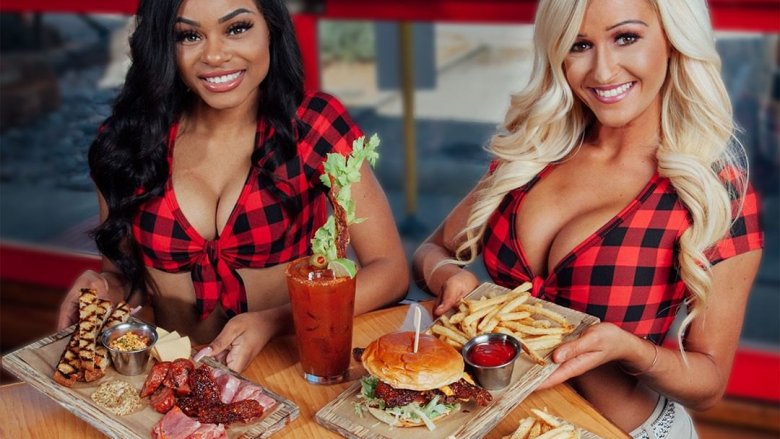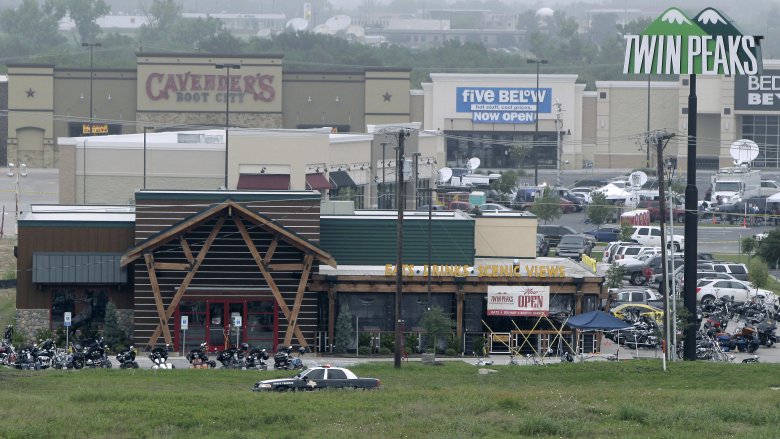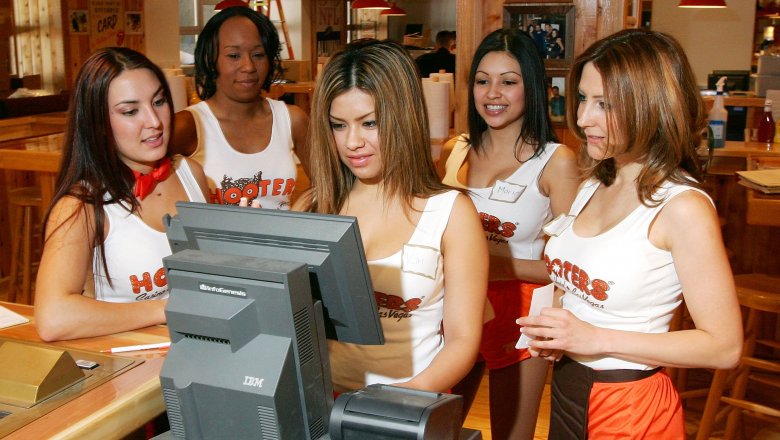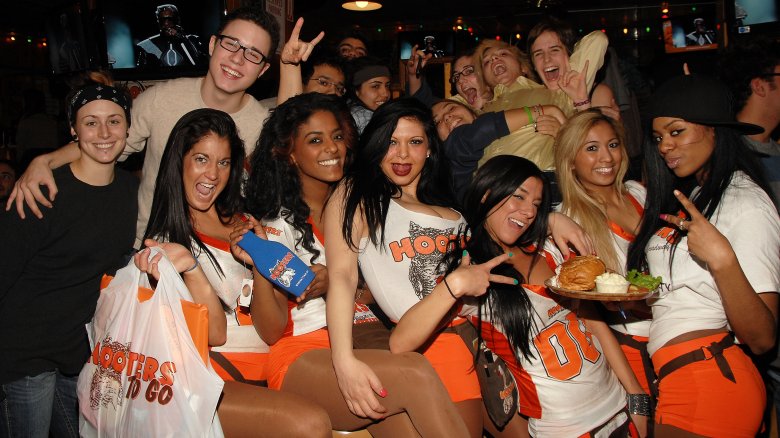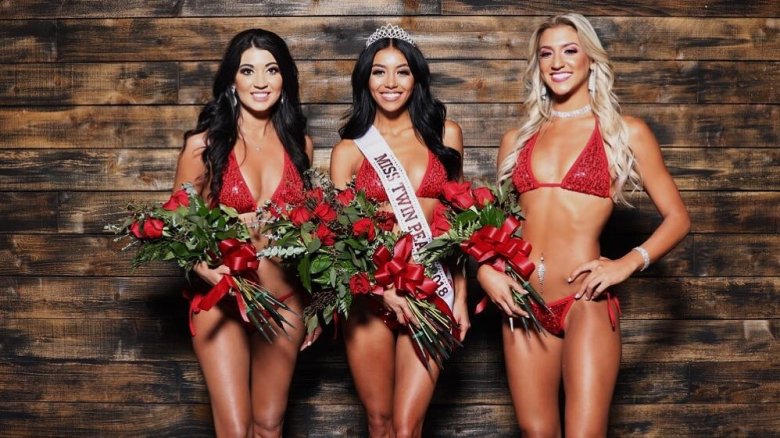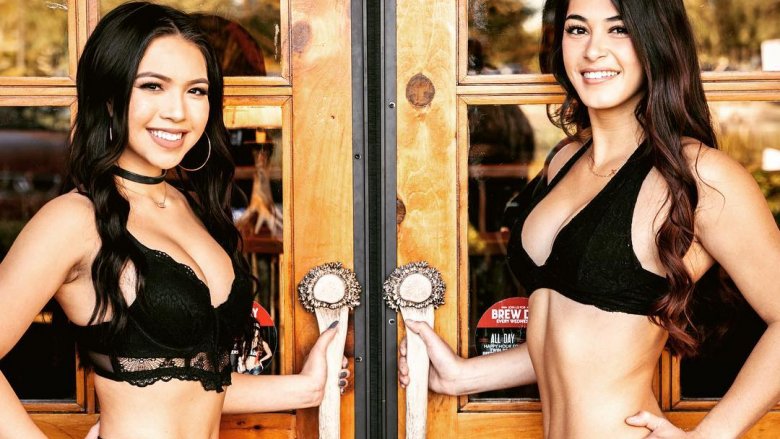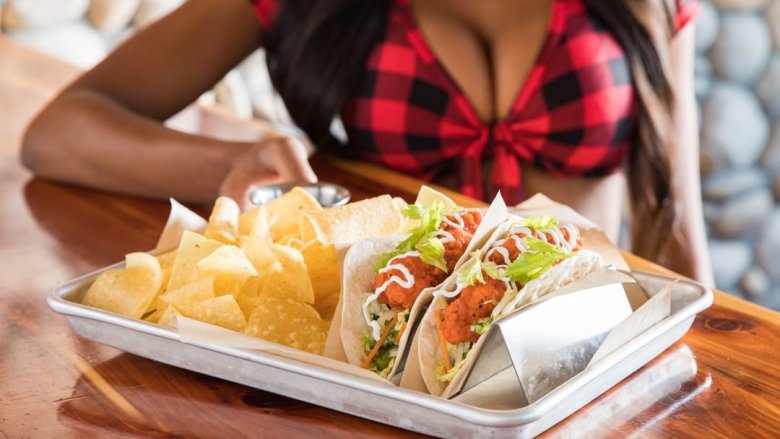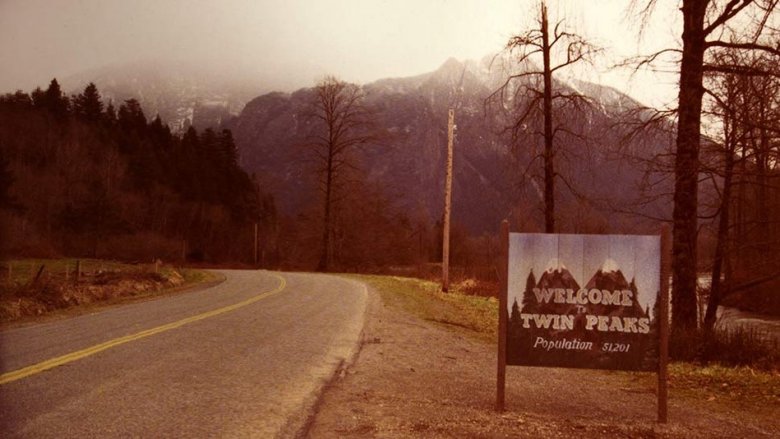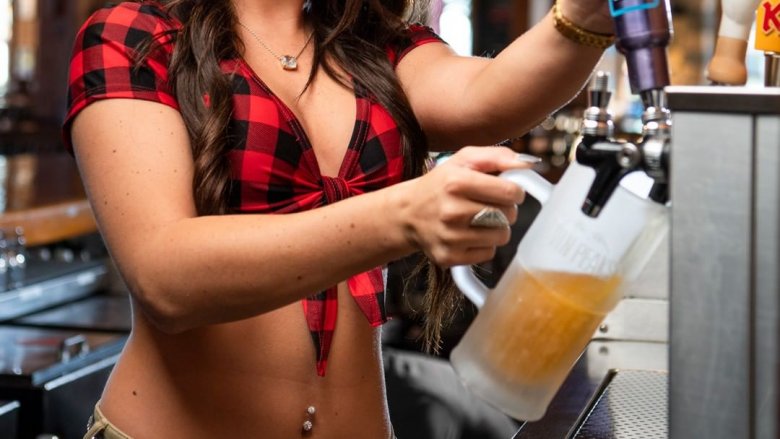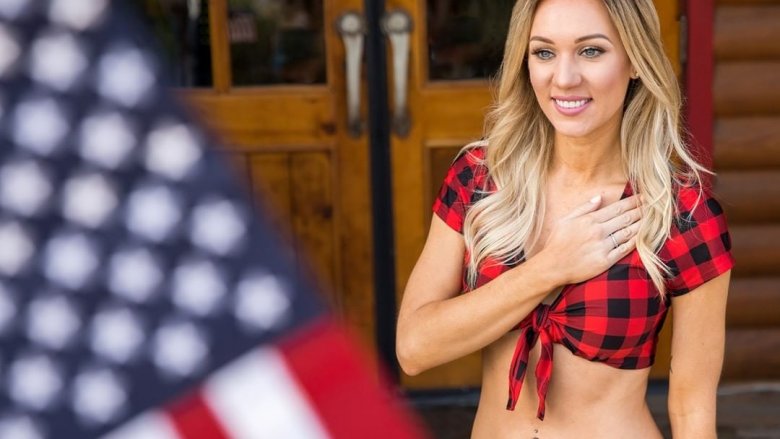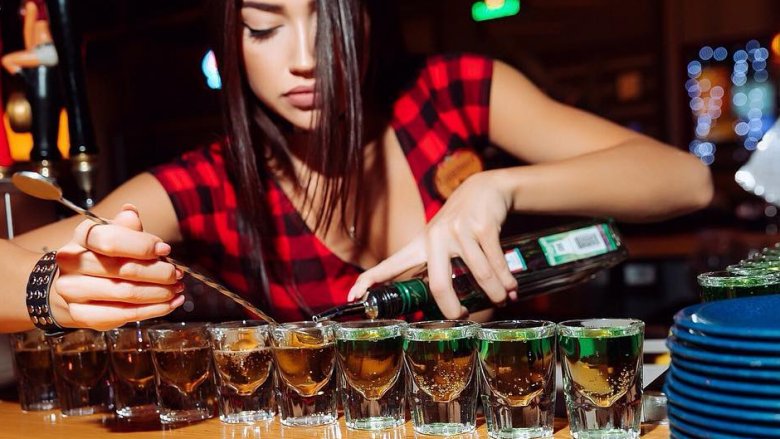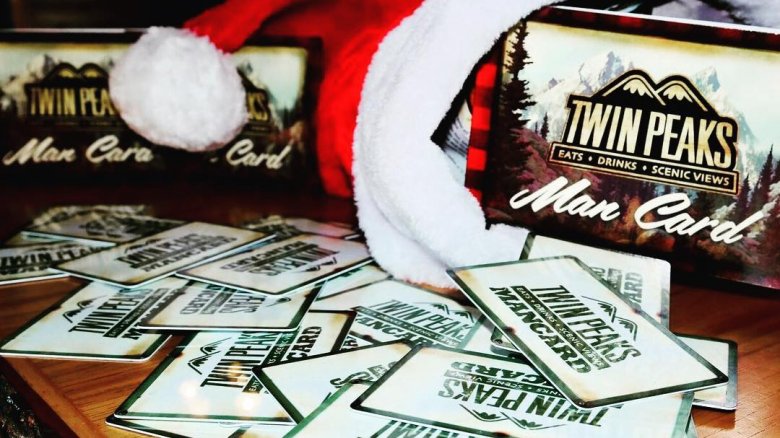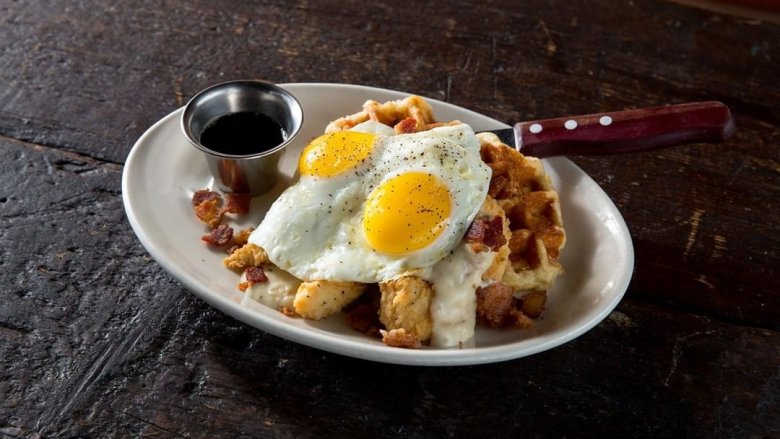The Untold Truth Of Twin Peaks Restaurants
If you've visited a Hooters at any point in your life, you're probably already pretty familiar with the overall Twin Peaks concept: Young, scantily-clad servers and hostesses, serving gigantic pitchers of beer and assorted bar food and feigning interest in the mostly male clientele, for a few hours of G-rated, family-friendly titillation. Hooters may have pioneered the concept, but competing chains like Twin Peaks have pushed the concept of "attentive service" restaurants (or, as they're more casually known, "breastraunts") so far that they almost make the orange-short-and-tank-top wearing Hooters girls seem downright wholesome by comparison.
Based in Dallas, Texas, each of Twin Peaks' more than 80 locations is themed to look like a fantasy version of a rustic mountain wilderness lodge, complete with large fireplaces, faux stonework, stuffed and mounted animal trophies, and dozens of gigantic television screens, with staff outfitted in midriff-and-cleavage-revealing cropped plaid shirts and khaki-colored shorts. But the standard-issue Twin Peaks uniform is tame compared to the outfits servers wear during so-called "theme weeks," which include swimsuits, lingerie, and revealing costumes.
It may seem ridiculous, but the strategy has translated into success. In 2014, Twin Peaks was the fastest-growing restaurant chain in the United States, with same-store sales outpacing trends in the overall dining industry and making it one of the strongest performers in the casual dining sector. But behind those cheerful smiles and platters full of boneless buffalo wings lies something of a dark side. Let's take a look at the untold truth of Twin Peaks.
It was the scene of a bloody biker shootout that left 9 dead
What happens when you take about 200 bikers from rival gangs in Waco, Texas, stir in over 100 weapons, a high-testosterone environment full of scantily-clad women and a never-ending flow of cheap, $3 shots of alcohol? You get one of the bloodiest, most brutal biker shootouts in American history... and it all happened at Twin Peaks.
On May 17, 2015, the restaurant hosted the quarterly meeting of the "Texas Confederation of Clubs and Independents," a local biker organization. Among the guests that day were a large number of representatives from two rival gangs, the Cossacks and the Bandidos, who had been involved in a years-long disagreement about who was entitled to wear a back patch with the word "Texas" along the bottom.
Area police had been tipped to a potential conflict brewing at the restaurant, and had begun to take up positions around the restaurant where 60 Cossacks were seated at the outdoor patio. Soon after, the Bandidos arrived, and mass pandemonium ensued; Wielding clubs, bats, knives, brass knuckles, and guns, the bikers fought one another, while inside the restaurant, waitresses and staff hid in bathrooms, under tables, and in the walk-in cooler. The police opened fire on the melee, and when the dust cleared, there were nine people dead, and at least 20 injured, resulting in over 150 arrests and zero convictions.
It was created because Hooters had become too tame
Twin Peaks customers have plenty to look at as they drag another tortilla chip through that crock of Chipotle Queso; the barely-there uniforms of the servers and hostesses are a big part of the attraction at each restaurant. If the concept doesn't seem wholly original, there's a good reason: Twin Peaks co-founder and then-CEO Randy DeWitt wasn't shy about citing his inspiration for the restaurant, in a 2014 profile by Bloomberg.
According to the magazine, "What was salacious three decades ago has now become family-friendly; it's not unusual to see children at Hooters, doodling in coloring books. And compared with the clothes at some popular teen retailers, Hooters's white tank tops and orange shorts seem almost demure. Last year, sales at the chain were virtually flat."
In 2005, DeWitt decided to experiment with a new concept that might recapture some of the original buzz of Hooters, creating a "more upscale" version of the bird-themed breastaurant pioneer. DeWitt wanted to offer better food, a full bar, and a trendier, rustic mountain lodge theme, while encouraging waitresses to show more of themselves.
"Hooters just wasn't racy enough," he explained. He seems to have solved that problem, for sure.
They were accused of stealing trade secrets from Hooters
In 2011, rival "breastaurant" pioneer chain Hooters sued Twin Peaks co-founder, Joseph Hummel, a former executive of the "delightfully tacky yet unrefined" restaurant chain. Hummel left Hooters to develop and launch Twin Peaks, and it seems he may have taken a few "trade secrets" with him when he left his former employer to start his new venture.
In their lawsuit, Hooters claimed that Hummel took "sensitive business information" with him. We know what you're thinking: What's so secret about a business model based entirely on clothing young women in revealing uniforms? But Hooters claimed that Hummel stole more than just the general idea of combining cleavage with chicken wings. According to The Huffington Post, "In the weeks leading up to his departure to Twin Peaks development partner La Cima Restaurants, Hummel downloaded and emailed to his private account a 'substantial volume' of Hooters documents, including plans related to management, recruitment, distribution and sales."
The lawsuit was settled out of court in 2012, with neither company acknowledging wrongdoing, and no financial compensation paid; Twin Peaks pinky-swore not to use the information they had obtained, and assured Hooters that no further use of "misappropriated information" would take place.
Waitresses get ranked before each shift
For a restaurant that bases a substantial part of its whole concept on "ogling," you may not be surprised to learn that the objectification of women at Twin Peaks is fairly commonplace; what's unusual, however, is how brazen the company is about evaluating staff members strictly on appearance, often seemingly in violation of the law.
Servers are given gym memberships, tanning salon packages, and appointments at nail salons, and provided diet, exercise, makeup, and hairstyling tips to help achieve that "NFL Cheerleader" aesthetic. Before each shift, staff members are evaluated on appearance and given a ranking, with servers who earn higher marks given more profitable sections of the restaurant and more lucrative tables for service, ensuring more customers and potentially higher tips.
How does the restaurant get away with this kind of institutionalized sexual harassment, that creates a toxic work environment and degrades and offends many of its waitresses? Twin Peaks (and similar restaurants) operate under a legal loophole, called a "bona fide occupational qualification," which allows them to ignore little things like the American Civil Rights Act of 1964 and freely discriminate on things like age, gender, and appearance, as long as it's "reasonably necessary" for the operation of their business. Staff at many "breastaurants" are hired not as servers, bartenders, or hosts, but as "actors or performers," and as such can have subjective standards of appearance, weight, makeup, hairstyle, breast size, body fat percentage, and uniform written into their hiring agreements.
Its employees have been cited for indecent exposure
The regular uniform at Twin Peaks is already revealing: Tiny khaki shorts, fur-lined boots, and a cropped, tied-at-the-ribs midriff-baring shirt with a deep plunging neckline. But Twin Peaks also sponsors occasional (and often mandatory) "theme weeks" for the staff, who swap the regular uniform for bikinis, skimpy Halloween costumes, and even lingerie, and that's when employees themselves may find themselves in hot water with the law.
According to one employee, local police officers visited her restaurant in February 2017, when Twin Peaks happened to be hosting a "lingerie week" for servers. She was cited for indecent exposure, because her costume left her buttocks uncovered. Yes, in a restaurant. Like, where food is served. No matter how big a fan of exposed rear ends you may be, that's kinda gross.
Restaurant management assured staff that they would "take care of the tickets," or that the charges would be dismissed, but instead hired attorneys to represent them in court and entered "guilty" pleas on their behalf. "The women now have records for indecent exposure, [and weren't] informed within a 30-day time frame so they could appeal," their attorney alleges.
They've been accused of systemic sexual harassment
Usually, when you hear about sexual harassment claims against a company, it's some rogue middle-manager, drunk on his own limited power, making untoward advances on members of his staff. In many cases, that one bad element is removed, the company issues some generic public relations messages, and the business proceeds along as usual, largely undamaged.
At Twin Peaks, the accusations have been much more severe, both in terms of how widespread the claims are, and for the corporate culture of harassment that appears to be baked into the foundation of the restaurant itself. In 2018, two former servers at Twin Peaks filed a complaint alleging that they were harassed at a Chicago area location of the restaurant, claiming that working there was tantamount to "work at a strip cub."
According to Grub Street, the servers alleged that they were forced to change into their uniforms in full view of the kitchen staff, and were required to send members of management photos of themselves in lingerie and bikinis from the dressing room to ensure that the outfits were "revealing" enough. Twin Peaks described the accusations as "outrageous" and "baseless." But the attorney for the two women, Tamara Holder, isn't so sure: She claims that the Chicago location's problems permeate the entire chain, and she's drafting a class action lawsuit for Twin Peaks employees nationwide.
It has nothing to do with the TV series
From 1990-1991, ABC viewers were treated to one of the most peculiar mystery dramas ever to appear in prime time, co-created by Mark Frost and renowned genre-bending film auteur David Lynch. On the surface, Twin Peaks was a simple show about the investigation of the disappearance of the local homecoming queen, but the numerous Lynchian twists and turns, which incorporated elements of horror, surrealism, the supernatural, and boatloads of soap opera-style campiness, propelled the series to cult classic status after only two seasons. It's revival series on Showtime more than two decades later was met with just as much excitement as the first.
So what's the connection between Twin Peaks, the pioneering David Lynch television series that some consider one of the greatest television series of all time, and Twin Peaks, the restaurant chain where you can eat fried pickles served to you by a half-naked lady wearing lingerie?
There isn't one. Though Twin Peaks founder Randy DeWitt was "a fan of the show" from the early 90s, he says that it "had nothing to do" with the name of his restaurant.
Their beer is served at almost freezing temperatures
Aside from the staff uniforms, one of the other features of Twin Peaks that keeps customers coming back is their super-cold beer, served in either 22-ounce "man-sized" mugs, or more demure 16-ounce portions. With dozens of different types of beer always on draft at every Twin Peaks location, in addition to the four house-brewed varieties (with names like "Dirty Blonde" and "Knotty Brunette"), there's a brew to please every palate.
But variety isn't the only secret to Twin Peaks' beer-slinging success; the restaurant also manages to serve beer in frozen mugs from specialized tap systems at a super-frosty 29 degrees, which the more science-inclined among us may recognize as almost-freezing — at least for beer, which freezes at 28 degrees Fahrenheit. While the superiority of cold beer may be a matter of some debate among beer enthusiasts, there's no doubt the gimmick is working to help set Twin Peaks apart from similar chains; according to former CEO Randy DeWitt, "If you can deliver a beer in August with ice crystals on it every single time, that's something special."
It was once designated the fastest-growing restaurant chain in America
If the notion of a restaurant being successful because it combines scantily-clad, big-haired waitresses dressed like sexy lumberjacks with spicy chicken wings and cold beer makes your eyes roll so hard into the back of your head that you temporarily go blind for just a moment, we can hardly blame you. But here's the thing: There is absolutely no question that the formula is working.
In 2014, Twin Peaks was the fastest-growing restaurant chain in America, sporting around $165 million dollars in annual sales. And while the uniforms and costumes may have been a little too racy for some, the biggest complaint at Twin Peaks seemed to be that the parking lot was always packed, making it difficult to land a table.
The expansion spike in 2014 was anything but a fluke, either. In fact, by years' end, sales had swelled to $240 million, "the largest increase of any restaurant company with at least $200 million in domestic sales," according to Forbes. That followed huge increases in 2013, 2012 and 2011. Those numbers are even more impressive when you consider Twin Peaks ended 2009 with just 10 locations, and had expanded to 64 restaurants by the end of 2014.
No matter what you think of the concept, customers have been flocking to the "scenic views" at Twin Peaks for years, and the chain is showing no signs of slowing down.
There's even a location in Russia
Though the restaurant chain has been expanding aggressively across the United States from its home base in Dallas, Texas, Twin Peaks hasn't cast an eye to its overseas influence... yet. In fact, there's just one international Twin Peaks location, and it's located in an unusual place: Kazan, Russia.
According to reviews on TripAdvisor, the Twin Peaks experience in Russia is strikingly similar to that in the United States; Waitresses wear the same revealing uniforms, slinging cold beer and classic American bar food in a paper mache facsimile of an American mountain lodge.
Newly-installed Twin Peaks CEO (and former Hooters exec) Joe Hummel plans to continue the expansion of the chain overseas. In an interview with Nation's Restaurant News, he explained that "[The Russia location has] done a nice job. They are looking at something in Moscow. We'll obviously look at the Asian markets — Singapore, China — and Europe, Canada and Mexico. At Hooters, we were in about 25 countries when we left in 2011. We're familiar with how to expand a brand internationally. "
The company sells a line of tasteful merchandise
If the orange-stained ring of chicken wing sauce around your mouth and the fuzzy, foggy memories of an attractive young woman pretending to be nice to you aren't enough of a souvenir to remind you of your night at Twin Peaks, you're in luck: The chain also sells a line of "tasteful" merchandise.
There are several T-shirt designs, ranging from simple logo tees to groan-inducing double entendres such as "I'm in love with a Dirty Blonde," as well as buffalo plaid underpants for the ladies, and T-shirts that read, "Classy, Sassy, and a Bit Smart Assy." Makes a great gift for mom!
But our favorite has to be the "Blonde Mouse Pad,"which features a photo of "Brittany" a generic blonde with the kind of approachable, nonthreatening girl-next-door come-hither stare that makes Twin Peaks an appealing dining destination for anyone with an unresolved fear of women. The mouse pad is die-cut into a shape that puts all of the emphasis squarely on Brittany's breasts, and ensures that under normal mouse-using conditions, your wrist will naturally fall right between her...well, you know. It's exactly the kind of item you need for your corporate desk job, when you find yourself thinking, "Y'know, it's been a long time since I've had a mandatory meeting with our company's Human Resources department."
The menu is actually pretty tame
In multiple profiles of the Twin Peaks empire and on the company's own website, the marketing team puts lots of emphasis on the relative quality of its food, compared to similar restaurants. "Everybody's a foodie nowadays," Twin Peaks CEO Joe Hummel explained to Business Insider. "You can't fool the consumer in today's world, with all the different food shows and food networks that are out there."
How does this translate to the Twin Peaks menu? The chain puts an emphasis on the "scratch made" aspects of its food, ostensibly pushing the boundaries of the tried-and-true, "Mugs n' Jugs" concept. This means that while standard pub fare like chicken wings and burgers are featured prominently on the menu, the chain also experiments with hipper gastropub fare, such as chicken and waffles, a "Hunter's Meat & Cheese Board," and a Nashville Hot Chicken Sandwich, as well as comfort food classics like pot roast, ribs, and ribeye steaks.
While the menu may seem more adventurous than you'd find at similar competing restaurants, it's hardly avant-garde or cutting edge. If you've eaten at a Chili's or an Applebee's at any point in your life, you're probably not going to find any surprises on the Twin Peaks menu, which tends to focus on the same hodgepodge of Southern cooking, Tex-Mex, and standard-issue pub grub.
